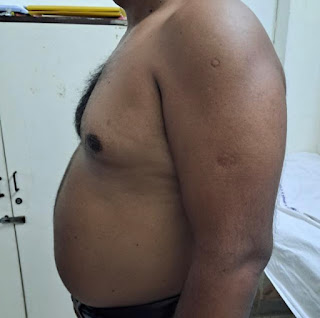58 year old Male with c/o pain abdomen since 2 days
This is an online e log book to discuss our patient de-identified health data shared after taking his / her / guardians signed informed consent. Here we discuss our individual patients problems through series of inputs from available global online community of experts with an aim to solve those patients clinical problem with collective current best evident based input.
This E blog also reflects my patient centered online learning portfolio and your valuable inputs on the comment box is welcome.
Hopi - patient was apparently alright till day before yesterday evening then he had pain in the epigastric region which is sudden in onset , gradually progressive , dragging type of pain , radiating to the umbilical region not associated with nausea and vomiting . Aggravating on taking food
No c/o fever , cold , cough , chest pain , SOB
Past history: similar complaints in the past in jan 2023 and jul 2023 , admitted in our hospital and treated as Alcoholic liver disease .
Personal history : bowel and bladder are regular .
Alcohol- daily 90ml since 30 yrs . Last drink day before yesterday.
Smoking - smokes chutta since 30 yrs . Daily 16 chutta .
General examination;
No pallor , icterus,cyanosis, clubbing,pedal edema , no lymphadenopathy
Vitals
Temp- afebrile
PR - 82 bpm
BP- 140/100mmHg
RR- 16CPM
Systemic examination
CVS- S1,S2 heard,no murmurs
RS - BLAE, NVBS
Per abdomen - Tenderness present in the epigastric region and left lumbar region
CNS - patient is conscious coherent and cooperative.
No neck stiffness
NORMAL
MOTOR SYSTEM-
TONE UL LL
RT N N
LT N N
SENSORY SYTEM - NORMAL
GLASGOW SCALE- 15/15
REFLEXES
BICEPS TRICEPS SUPINATOR
RT 2+ 2+ 2+
LT 2+ 2+ 2+
KNEE ANKLE
RT 2+ 2+
LT 2+ 2+
Provisional diagnosis: ? Acute pancreatitis
? Alcoholic hepatitis
Investigations:
Treatment:
1.Nil per oral
2.NS and RL 125ml/hr , DNS -25ml/hr
3.Inj . Thiamine 500mg in 100ml NS Over 20min OD
4.Inj.optineuron 1amp IV /OD
5.Inj.Tramadol 1amp in 100ml NS IV/sos
6.Tab. Lorazepam Po/TID
Osce questions :
1. What is the diagnostic criteria for acute pancreatitis?
Ans : 1) symptoms of pancreatitis like epigastric pain
2) three fold rise of serum amylase and serum lipase .
3) radiological features suggestive of pancreatitis
2. How does alcoholic hepatitis can cause portal hypertension?
Ans : there are various mechanisms which cause portal hypertension in alcoholic hepatitis patients including increased inflammation , increased intrahepatic vasoconstriction , increased portal inflow .
For detailed explanation please visit below link -
https://www.ncbi.nlm.nih.gov/pmc/articles/PMC10075503/
3. Is this patient has increased risk of developing portal HTN ?
Ans : Yes , because this is his 3rd episode in nearly 10 months . He doesn’t stop alcohol even after first 2 episodes which can aggravate his liver injury and can cause portal HTN by above mentioned mechanisms.
4.What are the key elements in the patient's history that raise suspicion for acute pancreatitis?How would you explore the patient's alcohol history further to assess the severity of alcohol use disorder?
- Ans :
- Key Elements in Patient's History: Sudden onset, gradually progressive epigastric pain radiating to the umbilical region, aggravated by food intake, history of alcohol consumption, previous admissions for similar complaints in Jan 2023 and Jul 2023.
- Exploring Alcohol History: Further inquire about the patient's daily alcohol intake, any recent changes in drinking patterns, and any attempts at reducing alcohol consumption. Use validated screening tools like AUDIT (Alcohol Use Disorders Identification Test).
- Ans :
- Conditions to Consider: Differential diagnoses include acute pancreatitis, alcoholic hepatitis, peptic ulcer disease, and biliary colic.
- Differentiating Acute Pancreatitis and Alcoholic Hepatitis: Look for serum amylase and lipase levels, imaging findings (e.g., CT scan), and specific liver function tests. Acute pancreatitis often presents with elevated amylase and lipase, while alcoholic hepatitis shows elevated transaminases with a significant history of alcohol abuse.
- Rationale for Medications:
- Thiamine: To prevent Wernicke's encephalopathy, common in chronic alcohol users.
- Optineuron: A combination of vitamins to address potential nutritional deficiencies.
- Tramadol: For pain relief.
- Lorazepam: To manage alcohol withdrawal symptoms.
- Monitoring Response: Evaluate the resolution of pain, improvement in vital signs, and serial laboratory tests (e.g., amylase, lipase, liver function tests) to gauge treatment effectiveness. Consider imaging follow-up for further assessment.
- Rationale for Medications:

















Comments
Post a Comment